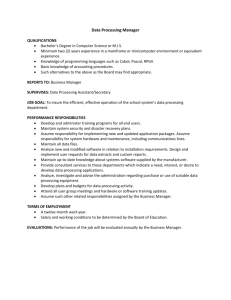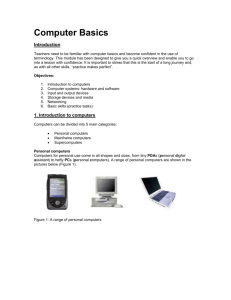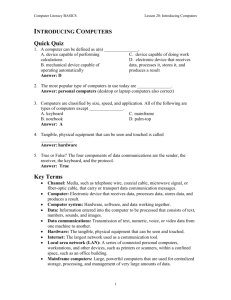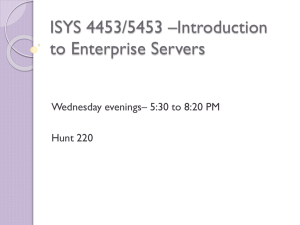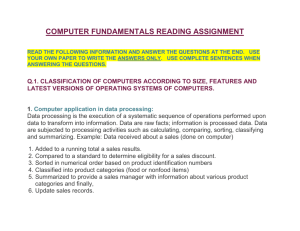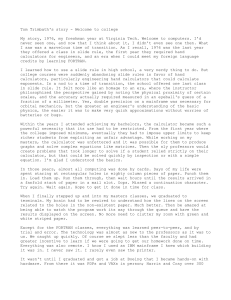Lack of Mainframe Programmers a Critical Issue for IT Organizations
advertisement
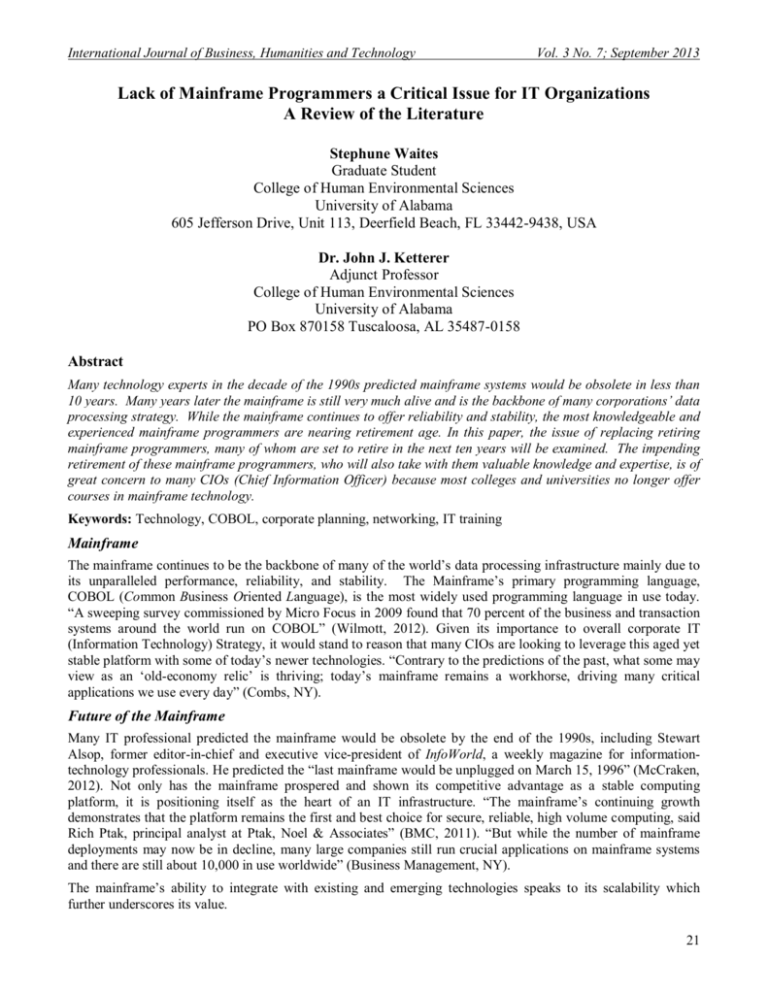
International Journal of Business, Humanities and Technology Vol. 3 No. 7; September 2013 Lack of Mainframe Programmers a Critical Issue for IT Organizations A Review of the Literature Stephune Waites Graduate Student College of Human Environmental Sciences University of Alabama 605 Jefferson Drive, Unit 113, Deerfield Beach, FL 33442-9438, USA Dr. John J. Ketterer Adjunct Professor College of Human Environmental Sciences University of Alabama PO Box 870158 Tuscaloosa, AL 35487-0158 Abstract Many technology experts in the decade of the 1990s predicted mainframe systems would be obsolete in less than 10 years. Many years later the mainframe is still very much alive and is the backbone of many corporations’ data processing strategy. While the mainframe continues to offer reliability and stability, the most knowledgeable and experienced mainframe programmers are nearing retirement age. In this paper, the issue of replacing retiring mainframe programmers, many of whom are set to retire in the next ten years will be examined. The impending retirement of these mainframe programmers, who will also take with them valuable knowledge and expertise, is of great concern to many CIOs (Chief Information Officer) because most colleges and universities no longer offer courses in mainframe technology. Keywords: Technology, COBOL, corporate planning, networking, IT training Mainframe The mainframe continues to be the backbone of many of the world’s data processing infrastructure mainly due to its unparalleled performance, reliability, and stability. The Mainframe’s primary programming language, COBOL (Common Business Oriented Language), is the most widely used programming language in use today. “A sweeping survey commissioned by Micro Focus in 2009 found that 70 percent of the business and transaction systems around the world run on COBOL” (Wilmott, 2012). Given its importance to overall corporate IT (Information Technology) Strategy, it would stand to reason that many CIOs are looking to leverage this aged yet stable platform with some of today’s newer technologies. “Contrary to the predictions of the past, what some may view as an ‘old-economy relic’ is thriving; today’s mainframe remains a workhorse, driving many critical applications we use every day” (Combs, NY). Future of the Mainframe Many IT professional predicted the mainframe would be obsolete by the end of the 1990s, including Stewart Alsop, former editor-in-chief and executive vice-president of InfoWorld, a weekly magazine for informationtechnology professionals. He predicted the “last mainframe would be unplugged on March 15, 1996” (McCraken, 2012). Not only has the mainframe prospered and shown its competitive advantage as a stable computing platform, it is positioning itself as the heart of an IT infrastructure. “The mainframe’s continuing growth demonstrates that the platform remains the first and best choice for secure, reliable, high volume computing, said Rich Ptak, principal analyst at Ptak, Noel & Associates” (BMC, 2011). “But while the number of mainframe deployments may now be in decline, many large companies still run crucial applications on mainframe systems and there are still about 10,000 in use worldwide” (Business Management, NY). The mainframe’s ability to integrate with existing and emerging technologies speaks to its scalability which further underscores its value. 21 © Center for Promoting Ideas, USA www.ijbhtnet.com “Given how integrated the mainframe is with other technologies, it’s no surprise that companies are seeking staff with both mainframe and distributed skill sets” (Combs, NY). IBM understands the strategic vision of CIOs and positions itself as the leader in mainframe technology. “A recent IDC study has reported that mainframe users plan a wave of investments in the IBM System z mainframe platform over the next two to five years, given the system's high availability, reliability, and security for mission-critical applications” (Saran, 2011). Skills Shortage The available data suggests that the mainframe will not be going away anytime soon, however, those who are the most experienced and most knowledgeable are nearing retirement age. “With mainframe applications critical to business, there is a concern that the complex knowledge needed to run mainframe applications is being lost as many of the staff involved in creating mainframes are reaching retirement” (Finnegan, 2012). Indeed, with the next wave of baby boomer mainframe programmers, those born between 1945 and 1964 are set to retire soon. “The average age of mainframe workers is 55 to 60, according to Dayton Semerjian, a senior vice-president at CA Technologies (CA), the second-largest maker of software for mainframe computers after IBM” (King, 2012). The mainframe skills shortage cannot be understated or its criticality minimized, “It is not a case of if it will impact you, it is more a case of when it will,” Richards told TechEye” (Finnegan, 2012). “This will be a growing problem very quickly," said Bob Paul, CEO of Compuware, a business software firm that gets 40% of its revenue from its mainframe division” (Yung, 2012). Many corporations incorporate outsourcing to augment their staffing; however, this is problematic given the time needed for knowledge transfer coupled with culture and time differences. Addressing Mainframe Skills Shortage While this issue may seem catastrophic, there is some cause for optimism as efforts to educate and train mainframe programmers are sprouting up from mainframe manufacturers, schools, and businesses. “The looming shortage has forced mainframe companies such as Compuware, IBM and CA Technologies to step up their talentdevelopment efforts” (Yung, 2012). IBM has stepped up its efforts in helping to address the impending shortage by establishing the IBM Academic Initiative. “The IBM Academic Initiative was established to provide educational resources to introduce undergraduates to the mainframe, and help students develop knowledge and practical skills that enable them to find jobs supporting and running mainframe systems” (Saran, 2011). According to IBM’s System Z Academic Initiative Program’s list of participating schools, roughly 85 are in the United States and Canada; And more than 1,000 worldwide. “The skills shortage has also prompted Compuware to team up with several Michigan universities to provide free mainframe software development training courses” (Yung, 2012). While these initiatives are steps in the right direction, are they enough to attract students of today who are exposed to video games, smart phones, mobile devices, and other application with modernized graphics? “The platform has not attracted the new generation of IT workers that prefer hot technologies like Java and Web 2.0 over the boring mainframe, which had negatively impacted CIO's ability to reskill their aging mainframe workforce” (Saran, 2011). Still, some, like CA Technologies have taken steps to modernized its mainframe interface to make it more appealing to younger students. “CA's mainframe management product, CA Mainframe Chorus, features a graphical interface and knowledge capture intended to modernize the mainframe experience to appeal to today's programmers and require less upfront knowledge” (Krill, 2011). Many young people are either unaware of mainframes or they are being steered towards newer technology with modern GUIs (Graphical User Interfaces). “One of the problems is attracting a new generation of workers, and there is a risk of continuing to deter a generation of potential employees if mainframes are not modernized” (Finnegan, 2012). Leading mainframe producers like IBM and CA Technologies will need to continue to develop more modern mainframes that appeal to the younger employees if they intend to remain a major player in IT strategies. The IT infrastructure of many corporations is so dependent on the mainframe, that they will undoubtedly employ a ‘teach new dogs old tricks’ strategy. According to Neil Richards, European mainframe director at Compuware says, “It sounds like a big problem but it is not insurmountable," he said. "You just need a plan in place.” (Finnegan, 2012). 22 International Journal of Business, Humanities and Technology Vol. 3 No. 7; September 2013 Summary Stewart Alsop, who boldly predicted the demise of the mainframe by March 1996, backtracked by saying, he wouldn’t see the last mainframe in his lifetime (McCraken, 2012). That is good news for many corporations that rely on the mainframe for data processing and for IBM, the largest mainframe producer. The good news is also the bad news in that those who develop, support, and maintain mainframes are close to retirement and their valuable knowledge leaves with them. There is a really big storm brewing, and we’ve known about it for years,” observes software consultant and contractor Robert Firestone. “If we don’t have mainframe systems supported by people who can support them well, banks, insurance companies and many other large operations are going to continue to have problems. It is way past too late to get started to fix this. All that can happen now is damage control. (Willmott, 2012). While mainframe technology is roughly 50 years old, there have been significant modifications along the way to make it more scalable and leverage new technologies like Linux, Web Apps, and Internet platforms. A career as a mainframe programmer can also provide a competitive salary where the range is 43K for entry-level to 107K for Application Developers (Indeed.com, 2013). “It is not as sexy as developing new mobile apps," Paul acknowledged. "But if you want a secure and highly valued career, this is a great place to go” (Yung , 2012). Corporations as well as schools are taking huge steps to ensure that the support needed to maintain mainframes is available. IBM’s Academic Initiative, which was established to provide educational resources to introduce undergraduates to the mainframe, has led the charge with [“more than 50,000 students having participated”] (Saran, 2011). The task for higher education and corporate trainers is clear: a new generation needs adequate Mainframe training. References BMC.com. (September 13, 2011) BMC Software: Survey Shows Mainframe Use Is Still Strong as Companies Start to Look at the Future of the Mainframe. Retrieved June 12, 2013, from http://www.bmc.com/news/press-releases/2011/bmc-survey-shows-mainframe-use-Is-still-strong.html Business Management. (ND). Capitalizing on a Mainframe Renaissance. Retrieved June 16, 2013, from http://www.busmanagement.com/article/Capitalizing-on-a-mainframe-renaissance/ Combs, M. (ND). Proof That the Mainframe Is Thriving in the Modern IT Age. Retrieved June 9, 2013, from http://enterprisesystemsmedia.com/article/proof-that-the-mainframe-is-thriving-in-the-modern-it-age Finnegan, M. (March 1, 2012). CIOs threatened with looming mainframe skills shortage. Retrieved June 12, 2013, from http://news.techeye.net/business/cios-threatened-with-looming-mainframe-skills-shortage Indeed.com. (2013) Mainframe Developer Salary. Retrieved June 12, 2013, from http://www.indeed.com/salary/Mainframe-Developer.html King, R. (August 3, 2010) Big Tech Problem as Mainframes Outlast Workforce. Retrieved June 12, 2013, from http://www.businessweek.com/stories/2010-08-03/big-tech-problem-as-mainframes-outlastworkforcebusinessweek-business-news-stock-market-and-financial-advice Krill, P. (December 1, 2011) IT's most wanted: Mainframe programmers. Retrieved June 12, 2013, from http://www.infoworld.com/d/data-center/its-most-wanted-mainframe-programmers-180453 McCraken, H. (August 28, 2012). The Mainframe Computer: Can’t Kill It. Retrieved June 12, 2013, from http://techland.time.com/2012/08/28/the-mainframe-computer-cant-kill-it/ Saran, C. (2011). Is the time right for a mainframe renaissance? Retrieved June 12, 2013, from http://www.computerweekly.com/feature/Is-the-time-right-for-a-mainframe-renaissance Yung, K. (August 15, 2012). Computer firms try to handle mainframe worker shortage. Retrieved June 12, 2013, from http://usatoday30.usatoday.com/tech/news/story/2012-08-15/Detroit-mainframe-workershortage/57066816/1 Wilmott, D. (August 28, 2012). Take Advantage of the Mainframe Talent Shortage. Retrieved June 12, 2013, from http://news.dice.com/2012/08/28/mainframe-talent-shortage/ 23

